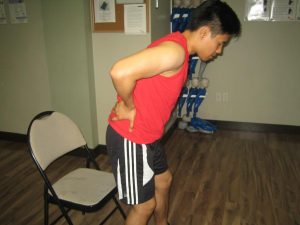A bulging disc injury is a spine injury persistent in the intervertebral disc of the spine. Generally, it can happen in the lumbar spine or the lower back, thoracic spine or the upper and middle back or the cervical spine.
A bulging disc is also called a slipped or bulging disc, but when the bulge of the disc is significant and it comes out of the annulus is called herniated disc.
A bulging or herniated disc happens when the cartilage found between the bones in the back moves out of place. The disc functions for the flexibility of the spine, they act as a shock absorber that lessen the pressure on the backbones when performing physical activities. Sometimes, the disc may bulge causing compression of the spinal nerve and cause a severe pain, numbness, tingling or weakness in the legs or arms.
Causes of bulging disc
- A repeated microtrauma for a long period such as having a poor posture. Poor posture when sitting, standing and working can stress the spine. Forward bending of the spine result to over-extension and weakening of the posterior fibrocartilage or annulus of the spinal disc.
Take a rest immediately after experiencing the symptoms. - A sudden unexpected load to the intervertebral discs that happens in traumatic situations such as vehicular accidents. Load or torsion of a disc causes tearing of the fibers of the annulus and injury to the disc.
- Genetic factors
Symptoms
- At first, coughing or sneezing
- Sitting
- Forward bending
- Lifting
- Pain in the leg
- Pins and needles sensations
- Lastly, numbness and weakness of the affected area
Treatment
- Take a rest immediately after experiencing the symptoms. Avoid resting for more than 2 days to prevent stiffness of the area and worsen the condition.
- Avoid activities that can worsen the symptoms.
- Strengthen the muscle of the back by performing exercises for the back and stretches with the help of the physical therapist.
- Apply ice packs to the back for at least 20 minutes for several times on the first 48 hours to lessen pain. Avoid applying ice directly on the skin to prevent frostbite and worsen the condition. Wrap ice in a towel or a piece of cloth before applying to the affected area.
- Apply heat on the back 48 hours after the injury to lessen stiffness. Cold and heat therapy can be applied alternately on the area is good for the condition.
- Take prescribed over-the-counter non-steroidal anti-inflammatory medication to lessen inflammation and pain.
Tips
- Perform at least 30 minutes of exercises five times a week such as biking, walking, dancing and swimming to prevent the muscles of the back becoming stiff and weak, increased stress on the back, restricted movements and increase the risk of developing herniated disc.
- Engage in aerobic exercises to increase flow of blood in the back and provide nutrients for fast healing. Perform aerobic exercises such as walking or swimming, strength training, and running.
FACT CHECK
https://physioworks.com.au/injuries-conditions-1/bulging_disc

